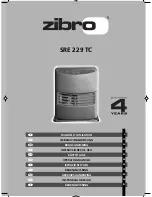
High Level (Outlet)
For heaters with a rated input of less than
60 kW — 4.5 cm
2
per kW of heat input
For heaters with a rated input of more than 60 kW
— 270 cm
2
plus for each kW of rated input over the
60 kW threshold an additional 2.25 cm
2
Alternatively mechanical input (not extract)
ventilation may be used in association with either
mechanical or natural extract and with a ventilation
flow rate of 2.16m
3
/h per kW of total rated input.
Mechanical ventilation systems where fitted must
be provided with safety interlocks to prevent heater
operation in case of air flow failure
Where the combustion air intake
is not ducted to
atmosphere
heater installed in flue only
configuration then ventilation can be via a
permanent ventilation opening / grille situated at
both Low level (Inlet) and high Level (Outlet) and
with the free area of such grilles as :-
Low level (Inlet)
For heaters with a rated input of less than
60 kW — 9.0 cm
2
per kW of heat input
For heaters with a rated input of more than 60 kW
— 540 cm
2
plus for each kW of rated input over the
60 kW threshold an additional 4.5 cm
2
High Level (Outlet)
For heaters with a rated input of less than
60 kW — 4.5 cm
2
per kW of heat input
For heaters with a rated input of more than 60 kW
— 270 cm
2
plus for each kW of rated input over the
60 kW threshold an additional 2.25 cm
2
Alternatively mechanical input (not extract)
ventilation may be used in association with either
mechanical or natural extract , and with a
ventilation flow rate of 3.24m
3
/h per kW of total
rated input
Where mechanical extract is used to complement
the above then the extract rate shall be 2.06m
3
/h
per kW of rated heat input
Mechanical ventilation systems where fitted must
be provided with safety interlocks to prevent heater
operation in case of air flow failure
2.9.3 Ventilation Openings and Grilles
Ventilation openings and grilles must communicate
directly with the outside air, be of negligible
resistance and shall be sited so that they cannot
easily be blocked of flooded
Caution
Additionally, an automatic control interlocked to the
burner must be fitted to ensure burner shutdown in
the event of airflow failure or restriction.
2.10 Air distribution system
All materials used within the construction of the
delivery and return air ducts must not represent a
fire hazard and should be made from thermally
inert materials.
The selection of materials must take account of the
environment into which the heater and its air
delivery system is expected to work, it must also
take account of the stresses and loadings placed
upon it during its normal working life.
Where interjoist spaces are used to route ducting
these must be lined with fire resistant insulation
material.
In installations where forced recirculation is a
feature, a full and unobstructed return air path to
the heater(s) must be provided, with return air
grilles connected by ducting directly to the return
air inlet on the heater.
The limit for recirculation should not be greater
than 85% re-circulated air to 15% fresh air.
If the inlet air is ducted to the outside, then the
lowest edge of the inlet air duct must be at least
500mm above the outside floor or ground level, it
must also be fitted with an access point(s) to allow
for cleaning and servicing.
The openings in the structure through which the
ductwork passes must be of fire resistant material
and constructed to prevent the likelihood of any fire
from spreading.
Summary of Contents for MH300
Page 2: ......
Page 22: ...Wiring Diagram 20 49 146...











































